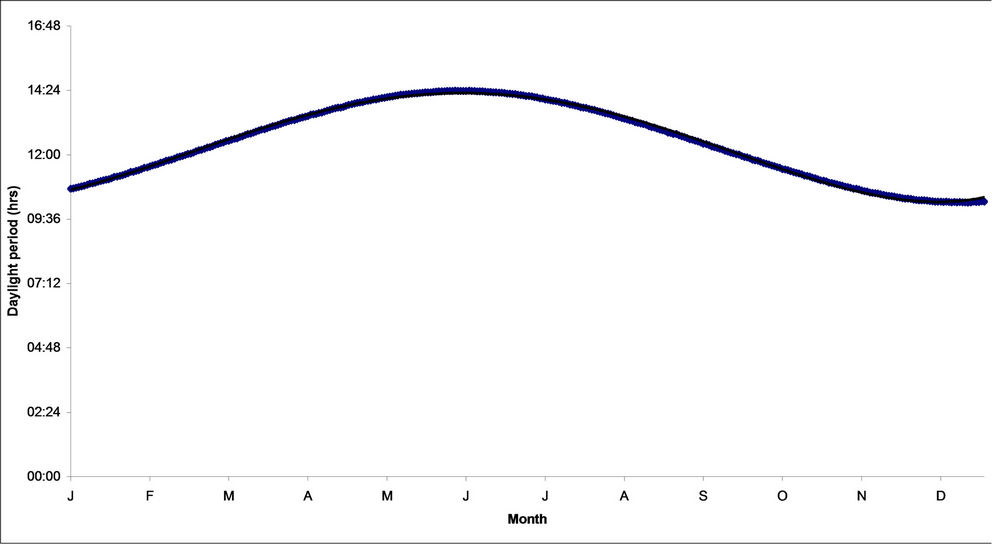Smart Grid and Renewable Energy
Vol.3 No.4(2012), Article ID:24420,7 pages DOI:10.4236/sgre.2012.34038
Solar Energy Optimization through Seasons: Case Study in Jordan
![]()
Department of Civil Engineering, Jerash University, Jerash, Jordan.
Email: argg22@yahoo.com
Received June 13th, 2012; revised September 17th, 2012; accepted September 24th, 2012
Keywords: Solar Energy; Optimization; Angle of Inclination; Seasons; DST; Electricity; Jordan
ABSTRACT
Solar energy in Jordan is recognized high amongst in the world. The solar energy cultivation needs to be magnified by optimizing the angle of inclination of solar cells. The angle of inclination in this work is not fixed but variable throughout the year, and consequently the angle is optimized for seasons. In this research, the optimized angles for seasons in Jordan are obtained as: 60˚ for Winter (November to February), 30˚ for Spring (March and April), 10˚ for Summer (May to August), and 30˚ for Fall (September and October). The optimized cultivated energy throughout all seasons in the year equals about 2490 kWh/m2. The residential customer consumption of electricity is 2475 kWh/customer per year. Therefore, according to Jordan, if the sun energy is converted efficiently to electricity, it will be worthy to apply for residential building for which each customer should have some area of solar cells to overcome the needs of energy. In addition, with some wise management of electricity in the daylight period, fossil fuel consumption will be minimized. Hence, combining solar energy concept in the design of building is an important step in sustainable development of green energy.
1. Introduction
Solar energy is a vital renewable energy due to its availability, continuity, and cleanness. Jordan is characterized by high solar radiation among regions in the world because it is located in the earth-sun belt area that has high potential solar energy. However solar radiation differs along the seasons. The distribution of total radiation on a horizontal surface over a day was examined by Liu and Jordan [1] who showed that the ratio of hourly to daily radiation could be correlated with the local day length and hour angle which differs through the year. The results of Liu and Jordan were confirmed by CollaresPereira and Rabl [2] using a wider database for the average distribution of solar radiation associated with different coordinates of time and place. Saraf and Hamad [3] found the yearly optimum tilt angle in Basra, Iraq was higher than the latitude by about 8˚. Both Gopinathan [4] and Soulayman [5] showed the optimum tilt angle of oriented sloping plates is almost equal to place latitude. Nijegorodov et al. [6] proposed a set of dozen expressions for determining the monthly optimal tilt angle for solar panels that set between latitude 60˚ north and 60˚ south. However, researcher have different approaches for optimal angles for solar collectors in different places, some come to good agreement and others come with conflict because the radiation pattern changes from location to location and time to time [6-8]. Singh and Tiwari have evaluated cloudiness factor and atmospheric transmittance for composite climate of New Delhi [9]. Solar energy encounters many parameters that affect its cultivation during the year such as sunshine duration, relative humidity, temperature, and cloudiness. The solar panels inclination therefore should be dynamically changed during the seasons at certain place.
Due to high and reliable solar irradiance in Jordan (5.5 kWh/m2·d), a domestic usage for solar energy in Jordan has high potential for about 330 sunny days per year using solar collectors [10]. Solar irradiance varies with season and time of the day due to the various sun positions under the unpredictable weather conditions [11]. Shariah et al. [12] showed that the yearly optimum angle in Jordan is less than the latitude by about 7˚. However that cannot be considered as a fixed value throughout the months and seasons. A better place for solar energy is located in the eastern Jordanian desert. In desert, the yearly average daily sunshine is 9.3 hours as measured at Al-Risha region, which is located on 32˚ latitude. The solar panels are to be installed inclined toward the South at 32˚ with the horizontal facing southward. Modules inclination adjustments of ±15˚ are needed to track the sun’s seasonal variations [13].
This article focuses on determining the best installation of solar panel inclination angle in Jordan throughout seasons to sustain optimal solar energy cultivation.
2. Methodology and Approach
Due to the sun travel along the year, the sun irradiations are different throughout the seasons. Therefore the solar panels should be dynamically inclined with different angles during seasons. This article depends upon solar energy data sets and modeling techniques. The information about solar energy, sun shine hours, temperature, and electricity has been gathered from different organizations namely: National Center for Research and Development, Ministry of Energy and Mineral Resources, Jordan Meteorological Department, and time and date calendar website. Modeling techniques entail Meteonorm Version 6 software for modeling solar energy with inclination angle of panel in Jordan. In this work, seasons in Jordan are categorized as the following: Winter (November to February), Spring (March and April), Summer (May to August), and Fall (September and October).
The solar energy is optimized each season to highest energy value with specific angle of inclination. The optimization procedure is performed by spread sheet analysis. The value of the solar energy cultivated yearly is compared with the electricity consumed in residential buildings by the year in Jordan to check whether solar system can conquer electricity consumption or not.
3. Solar Energy and Electricity in Jordan
One of the scopes of this research is to prove that the collected solar energy compensates the electrical energy consumption in residential buildings (Table 1) [14]. Other scope is to make one scenario for solar energy exaggeration by dynamically optimizing cell angle of inclination through the year, and other scenario for electrical energy consumption reduction by daily wise management. The idea of using solar renewable energy is to reduce using fossil fuels. Fossil fuel depletes and costly increases with the time, furthermore it causes environmental problems such as global warming. The focus upon the sun energy utilization entails the approach of cultivating sunshine efficiently. Therefore solar cells must be oriented and distributed effectively. The savings of electricity can be enhanced by adjusting the daily habits of wakeup and sleep. The daylight period assist in utilizing the natural sunlight instead of electricity [15]. The implementation of Daylight Saving Time (DST) creates an additional hour of higher outdoor air temperature and solar radiation during the primary cooling times of the evening [16]. California Energy Commission [17,18] conducted a simulation-based study to examine the effects of DST on statewide electricity consumption. Consequently by concise management, collecting sun irradiation and fitting the daily man activities to sunshine

Table 1. The estimation of the annual consumption for each customer in residential building in Jordan.
will compensate electricity for residential building.
The data about the solar energy in Jordan provides knowledge base for energy modeling and management. Figure 1 shows the global daily solar energy (kWh/m2) throughout months of the year in Jordan [19]. Table 2 and Table 3 provide daily solar energy (kWh/m2) for areas in Jordan for different years [20]. The aforementioned data accumulates an average energy value on the yearly basis of about 2080 kWh/m2.
The solar energy is proportional to the daylight time as a major parameter. Figures 2 and 3 show the daylight time in Jordan from the sunrise to the sunset as it is cited from time and date calendar website [21]. However the sunshine period does not cover all the daylight time. Figure 4 depicts the sunshine period as it is demonstrated by Jordan Meteorological Department [19].
In this article, all the information obtained about the sun energy can be modeled via analytical soft computational programs that models, manages and forecasts the energy for specific place with variable angle of inclination.
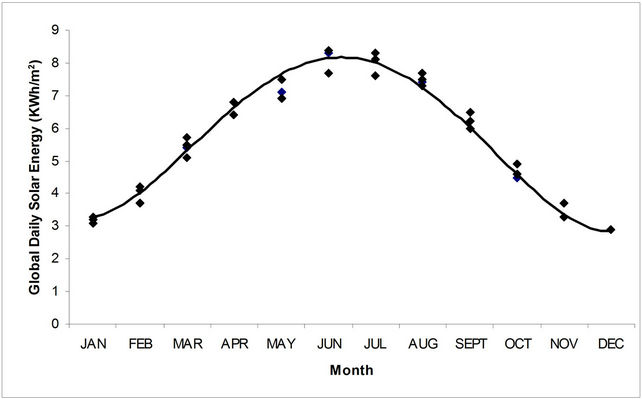
Figure 1. Data of solar energy during the year in Jordan.

Table 2. Average daily solar radiation (Wh/m2·d) through months for the year 2010 in Jordan.

Table 3. Average daily solar radiation (Wh/m2·d) for the years (2004-2010) in Jordan.

Figure 2. The time of the daylight, sunrise and sunset during the year in Jordan.

Figure 4. Data of sunshine period during the year in Jordan.
4. Solar Energy Cultivation through Seasons
In this section, the information of solar energy in Jordan is being modeled for different angle of solar panel inclination. Meteonorm version 6 uses data bases about the specified place and gives the estimated solar energy. It comprises physical and environmental parameters applicable for certain coordinate. The estimation of solar energy is being adjusted for different angle of orientation of solar panel due to sun movement during the months of the year. The modeling process is shown on the findings of Figure 5 that depicts the solar energy throughout the months in the year for different solar cell inclination. Depending on the figure we can choose the best angle of inclination for each month or season.
In Jordan, the year is classified into four seasons: Summer, Fall, Winter, and Spring. The Summer season extends from May until August. The Fall is characterized to be in September and October. Winter extends from November until February, and Spring denotes to March and April. Figure 6 represents each season and the solar energy associated with it within variable angle of inclination. The curves in the Figure show that the highest solar energy gained in Summer for the best angle of 10˚. In addition, the energy cultivated during four month in Winter is larger than other shorter terms of Spring and Fall. The best angle of inclination in winter is sustained at 60˚. According to the Figure the overall energy gained in fall is higher than that in spring, and both have the maximum collected energy at 30˚ angle of inclination.
Consequently, the focus here is to optimize solar energy cultivation along the year. Hence the angle of inclination is given the great attention. Many researches leave the angle ignorant and keep the solar panels horizontal, or fix the angle of inclination at certain orientation all over the year. Regard to this work, the angle of inclination is dynamically variable along seasons in the year. Figure 7 summarizes the optimal angles of inclination for each season in Jordan.
The optimized solar energy cultivated upon yearly basis is computed to be 2490 kWh/m2 (Table 4). This value overcomes the value of general solar 30˚ fixed cells (2080 kWh/m2) that seen in literature. Furthermore, this optimized solar energy (Table 4) competes the value of electricity consumption for residential building per year for single customer (Table 1). The findings of this research prove that it is worthy to use solar cells for residential building as a green application. It is worthy to take in consideration that solar cells can overcome one customer need of energy in the year. Consequently, the area occupied by solar panels, the solar energy conversion efficiency, and the angle of inclination are important parameters. Hence the idea of utilizing solar renewable energy in building design is a vital step in sustainable development for green buildings.
5. Conclusion
Jordan is one of places that it is recognized of high solar radiation. The solar energy cultivation needs to be optimized by taking in consideration the angle of solar cell inclination. As the sun travels in its orbital alignment through the year, the angle of inclination needs to be dynamically variable. The angle of inclination and solar energy in this research is optimized for each month and so for each season. According to Jordan the sun energy is worthy for all four seasons. The results of this research show that the solar energy can serve the residential building consumption of electricity. In fine, the area occupied by solar panels, the solar energy conversion effi-
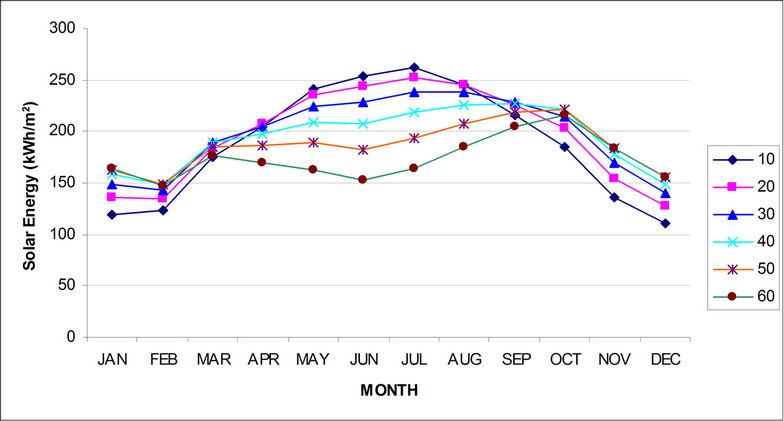
Figure 5. Solar Energy during months of the year for different solar cell inclination in Jordan.
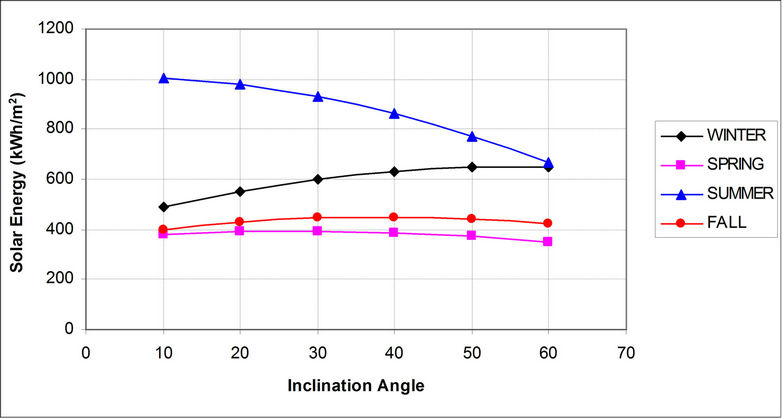
Figure 6. Solar energy for different solar cell inclination in each season in Jordan.
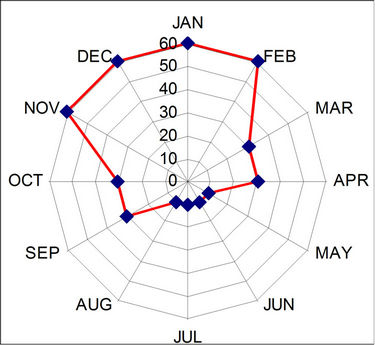
Figure 7. The optimal solar cell angle of inclination in each season in Jordan.
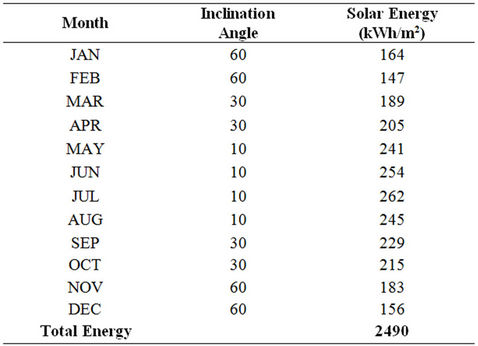
Table 4. The optimal solar energy cultivated during the year in Jordan.
ciency, and the angle of inclination are important parameters in combining solar energy concept in the design of building, and that is an important step in sustainable development of energy.
6. Acknowledgements
Jerash University Presidency and Deanship of Scientific Research is gratefully acknowledged
REFERENCES
- B. Y. H. Liu and R. C. Jordan, “The Interrelationship and Characteristic Distribution of Direct, Diffuse and Total Solar Radiation,” Solar Energy, Vol. 4, No. 3, 1960, pp. 1-19. doi:10.1016/0038-092X(60)90062-1
- M. Collares-Pereira and A. Rabl, “The Average Distribution of Solar Radiation Correlation between Diffuse and Hemispherical and between Daily and Hourly Isolation Values,” Solar Energy, Vol. 22, No. 2, 1979, pp. 155-164. doi:10.1016/0038-092X(79)90100-2
- G. R. Saraf and F. A. W. Hamad, “Optimum Tilt Angle for a Flat Plate Solar Collector,” Energy Conversion and Management, Vol. 28, No. 2, 1988, pp. 185-191. doi:10.1016/0196-8904(88)90044-1
- K. K. Gopinathan, “Solar Radiation on Variously Oriented Sloping Surfaces,” Solar Energy, Vol. 47, No. 3, 1991, pp. 173-179. doi:10.1016/0038-092X(91)90076-9
- S. Sh. Soulayman, “On the Optimum Tilt of Solar Absorber Plates,” Renewable Energy, Vol. 1, No. 3-4, 1991, pp. 551-554. doi:10.1016/0960-1481(91)90070-6
- N. Nijegorodov, K. R. S. Devan, P. K. Jain and S. Carlsson, “Atmospheric Transmittance Models and an Analytical Method to Predict the Optimum Slope of an Absorber Plate, Variously Orientated at Any Latitude,” Renewable Energy, Vol. 4, No. 5, 1994, pp. 529-543.
- H. Gunerhan and A. Hepbasli, “Determination of the Optimum Tilt Angle of Solar Collectors for Building Applications,” Building and Environment, Vol. 42, No. 2, 2007, pp. 779-783. doi:10.1016/j.buildenv.2005.09.012
- M. Ab. H. M. Yakup and A. Q. Malik, “Optimum Tilt Angle and Orientation for Solar Collector in Brunei Darussalam,” Renewable Energy, Vol. 24, No. 2, 2001, pp. 223-234. doi:10.1016/S0960-1481(00)00168-3
- H. N. Singh and G. N. Tiwari, “Evaluation of Cloudiness, Haziness Factor for Composite Climate,” Energy, Vol. 30, No. 9, 2005, pp. 1589-1601. doi:10.1016/j.energy.2004.04.036
- J. Jarras, “Feasibility of a Fund for Financing Solar Water Heaters and Projects Related to the Promotion of Renewable Energies in Jordan,” MEMR Press, Amman, 1987.
- D. H. W. Li and J. C. Lam, “An Analysis of Climatic Variables and Design Implications,” Architectural Science Review, Vol. 42, No. 1, 1999, pp. 15-25. doi:10.1080/00038628.1999.9696844
- A. Shariah, M. A. Al-Akhras and I. A. Al-Omari, “Optimizing the Tilt Angle of Solar Collectors,” Renewable Energy, Vol. 26, No. 4, 2002, pp. 587-598. doi:10.1016/S0960-1481(01)00106-9
- Meteorological Department, Climate Division, “Jordan Climatic Data,” 2007.
- Ministry of Energy and Mineral Resources MEMR, “Ana-lytical Study Report,” Jordan, 1996.
- Wikipedia. Daylight Saving Time, 2012. http://en.wikipedia.org/wiki/Daylight_saving_time
- Y. Shimoda, T. Asahi, A. Taniguchi and M. Mizuno. “Evaluation of City-Scale Impact of Residential Energy Conservation Measures Using the Detailed End-Use Simulation Model,” Energy, Vol. 32, No. 9, 2007, pp. 1617-1633. doi:10.1016/j.energy.2007.01.007
- A. Kandel and D. Metz, “The Effects of Daylight Saving Time on California Electricity Use,” California Energy Commission, 2001.
- A. Kandel, “Electricity Savings from Early Daylight Saving Time,” California Energy Commission, 2001.
- Jordan Meteorological Department, Annual Climate Bulletin, Amman, Jordan, 2007.
- National Center for Research and Development, “Energy Research Program,” Jordan Solar Irradiance and Ambient Temperature Bulletin for the years 2004-2010.
- Time and Date Calendar, 2012. http://www.timeanddate.com


